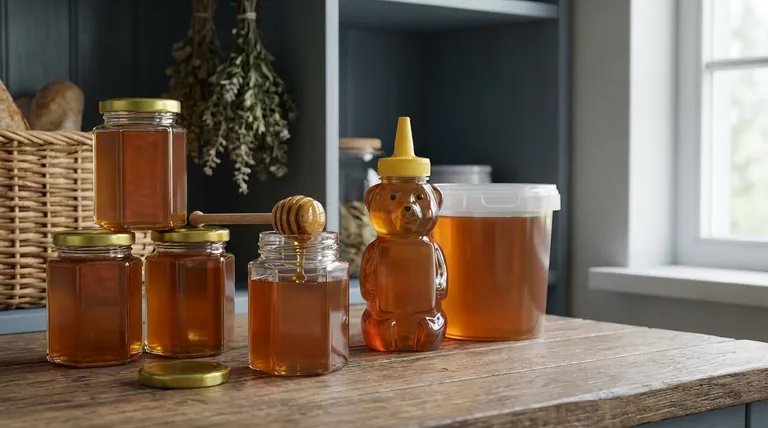For long-term storage and preserving purity, glass is the superior choice for honey. Its non-porous and inert nature ensures there is no risk of chemicals leaching or flavors being altered over time. However, for everyday use and convenience, a high-quality, food-grade plastic container is perfectly safe and acceptable.
The choice between glass and plastic is less critical than the three core principles of honey storage: an airtight seal, a stable and cool temperature, and protection from direct sunlight. Mastering these fundamentals will do more to preserve your honey's quality than the container material alone.

The Core Principles of Honey Storage
Before comparing materials, it's essential to understand the environmental factors that degrade honey. The right container is simply a tool to control these factors.
An Airtight Seal is Non-Negotiable
Honey is hygroscopic, meaning it readily absorbs moisture from the air.
If left unsealed, this excess moisture can raise the water content, leading to fermentation and spoiling the honey. A tightly secured lid is your first line of defense.
A Stable, Cool Temperature is Key
The ideal storage temperature for honey is between 65°F and 75°F (18°C to 24°C).
Extreme heat can degrade its delicate enzymes and aromas, while cold temperatures—especially refrigeration—will significantly accelerate crystallization.
Avoid Direct Sunlight
Ultraviolet (UV) light can break down the beneficial enzymes and antioxidants in honey, diminishing its nutritional value and quality. Storing honey in a dark pantry or cupboard is crucial.
Glass vs. Plastic: A Detailed Comparison
With the core principles established, we can evaluate how each material serves these goals.
The Case for Glass: Purity and Longevity
Glass is the gold standard for archival storage. Because it is inert and non-porous, it offers zero risk of chemical leaching or flavor absorption.
This makes glass the ideal choice for storing high-quality raw honey for years, ensuring its taste remains unchanged. Opaque or amber-colored glass jars provide the added benefit of excellent UV protection.
The Case for Plastic: Convenience and Practicality
Plastic containers are lightweight, shatter-resistant, and generally more cost-effective, making them highly practical for daily use.
It is critical to ensure the plastic is a food-grade material like PET (polyethylene terephthalate) or HDPE (high-density polyethylene) and is BPA-free. While perfectly safe, plastic is slightly more permeable than glass, which may introduce a minimal risk of taste alteration over many years of storage.
Understanding the Trade-offs and Pitfalls
Proper storage involves avoiding common mistakes that can ruin honey, regardless of the container.
The Risk of Oxidation
You should never store honey in metal containers. The natural acids in honey can react with the metal, causing oxidation. This reaction can contaminate the honey and alter its flavor profile.
This is why lids on glass jars are typically lined with a non-reactive material. The warning also extends to non-food-grade plastics, which can also leach chemicals and cause oxidation.
The Inevitability of Crystallization
Crystallization is a natural process where glucose separates from the water in honey, forming sugar crystals. It is not a sign of spoilage.
While temperature fluctuations are the primary driver, the container has little effect. If your honey crystallizes, simply place the open jar in a warm water bath and stir gently until the crystals dissolve.
Making the Right Choice for Your Goal
Select your storage container based on how you plan to use and store your honey.
- If your primary focus is long-term archival or bulk storage: A dark or amber-colored glass jar with an airtight lid is the undisputed best choice for preserving purity.
- If your primary focus is daily use and convenience: A food-grade, BPA-free plastic container offers practicality without any significant compromise in quality or safety.
- If your goal is to prevent degradation above all: Prioritize a cool, dark storage location, as this will have a greater impact than the container material itself.
Ultimately, a proper seal and the right environment are the most critical factors in keeping your honey safe and delicious.
Summary Table:
| Storage Goal | Recommended Container | Key Considerations |
|---|---|---|
| Long-Term / Archival Storage | Glass (preferably amber) | Inert, non-porous, blocks UV light, best for purity. |
| Daily Use / Convenience | Food-Grade, BPA-Free Plastic | Lightweight, shatter-resistant, practical for frequent use. |
| Critical Factor | Airtight Lid & Cool/Dark Location | More important than material for preventing spoilage. |
Ensure your honey's quality with the right supplies from HONESTBEE.
Whether you are a commercial apiary storing large quantities or a beekeeping equipment distributor sourcing for your customers, the right storage containers are crucial for maintaining product integrity. HONESTBEE supplies high-quality, wholesale beekeeping supplies and equipment designed for durability and performance.
Let us help you equip your operation with the best tools for success. Contact our team today to discuss your wholesale needs!
Visual Guide

Related Products
- Hexagonal Glass Honey Jars with Metal Lug Caps Elegant Versatile Packaging
- Classic Drum Shaped Glass Honey Jar with Airtight Lid
- Inverted Squeezable Honey Jar with No Drip Flip Top Cap for Easy Pouring
- Classic Honey Bear Jars with Flip Top Dispensing Cap for Liquid Sweeteners
- Stainless Steel Honey Tank Stand for Honey Storage
People Also Ask
- What are the common types of honey packaging? A Guide to Glass, Plastic, Pouches & Tins
- What makes raw honey more aesthetically appealing than processed honey? Discover the Beauty of Authenticity
- How many jars of honey do you get from a hive? Unlock Sustainable Harvesting Secrets
- What is done with the honey after extraction and filtering? From Purification to Perfect Packaging
- What is the best way to jar honey? Preserve Quality with the Right Container



















